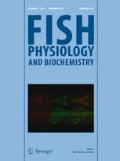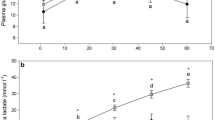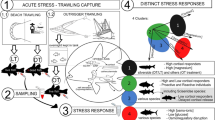Abstract
Secondary effects of capture and handling stress in the Atlantic sharpnose shark, Rhizoprionodon terraenovae, were investigated in this study. Twenty-four sharks were serially bled and changes in several hematological parameters were monitored over a 1-h time period, following capture by hook-and-line. Blood samples were obtained from each shark at 0, 15, 30, 45 and 60 min. All 0-min (initial) blood samples were obtained within 3 min of capture. Blood glucose (9.2–13.1 mmol l−1), lactate (1.5–28.9 mmol l−1), and plasma osmolality (871–929 mOsm kg−1) all increased after capture, whereas blood pH (6.86–6.78) declined. Hematocrit values (initial = 25.1%) remained unchanged throughout the 1-h stress period. Due to the short amount of time it took to obtain the initial sample and the lack of a significant relationship between the initial time and the initial parameter levels, all initial samples are considered the best approximation of the predisturbance resting levels. The use of repeated measures in this study enables us to describe the dynamics of the secondary stress response in the Atlantic sharpnose shark.
Similar content being viewed by others
REFERENCES
Barton B.A., Peter, R.E. and Paulencu, C.R. 1980. Plasma cortisol levels of fingerling rainbow trout (Salmo gairdneri) at rest, and subjected to handling, confinement, transport, and stocking. Can. J. Fish. Aquat. Sci. 37: 805–811.
Barton, B.A., Schreck, C.A. and Sigismondi, L.A. 1985. Multiple acute disturbances evoke cumulative physiological stress responses in juvenile Chinook salmon. Trans. Am. Fish. Soc. 115: 245–251.
Barton, B.A. and Iwama, G.K. 1991. Physiological changes in fish from stress in aquaculture with emphasis on the response and effects of corticosteroids. Ann. Rev. Fish Dis. 1: 3–26.
Barton, B.A. 1996. Stress in finfish: past, present and future – a historical perpective. In: Fish Stress and Health in Aquaculture. pp. 1–33. Edited by A.D. Pickering and J. Sumpter. Cambridge University Press.
Beggs, G.L., Holeton, G.F. and Crossman, E.J. 1980. Some physiological consequences of angling stress in muskellunge, Esox masquinongy Mitchill. J. Fish Biol. 17: 649–659.
Black, E.C. 1957. Alterations in the blood level of lactic acid in certain salmonoid fishes following muscular activity. III. Sockeye salmon, Oncorhynchus nerka. J. Fish. Res. Bd. Can. 14: 807–814.
Butler, P.J., Taylor, E.W. and Davison, W. 1979. The effects of long term, moderate hypoxia on acid-base balance, plasma catecholamines and possible anaerobic end products in the unrestrained dogfish Scyliorhinus canicula. J. Comp. Physiol. 132: 297–303.
Cash, W.B., Holberton, R.C. and Knight, S.S. 1997. Corticosterone secretion in response to capture and handling in free-living redeared slider turtles. Gen. Comp. Endocrinol. 108: 427–433.
Cliff, G. and Thurman, G.D. 1984. Pathological and physiological effects of stress during capture and transport in the juvenile dusky shark, Carcharhinus obscurus. Comp. Biochem. Physiol. 78A: 167–173.
Coddington, E.J. and Cree, A. 1995. Effects of acute captivity stress on plasma concentrations of corticosterone and sex steroids in female whistling frogs (Litoria ewingi).Gen. Comp. Endocrinol. 100: 33–38.
Cooper, A.R. and Morris, S. 1998. The blood respiratory, hematological, acid-base and ionic status of the Port Jackson shark, Heterodontus portusjacksoni, during recovery from anaesthesia and surgery: a comparison with sampling by direct caudal puncture. Comp. Biochem. Physiol. 119A: 895–903.
DeRoos, R. and DeRoos, C.C. 1978. Elevation of plasma glucose by catecholamines in elasmobranch fish. Gen. Comp. Endocrinol. 34: 447–452.
DeRoos, R. and DeRoos, C.C. 1992. Effects of mammalian ACTH on potential fuels and gluconeogenic substrates in the plasma of the spiny dogfish shark, Squalus acanthias. Gen. Comp. Endocrinol. 87: 149–158.
Evans, D.H. and Kormanik, G.A. 1985. Urea efflux from the Squalus acanthias pup: the effect of stress. J. Exp. Biol. 119: 375–379.
Hazon, N. and Henderson, I.W. 1985. Factors affecting the secretory dynamics of 1á-hydroxycorticosterone in the dogfish, Scyliorhinus canicula. Gen. Comp. Endocrinol. 59: 50–55.
Iwama, G.K., McGeer, J.C. and Pawluk, M.P. 1989. The effects of five fish anaesthetics on acid-base balance, hematocrit, blood gases, cortisol, and adrenaline in rainbow trout. Can. J. Zool. 67: 2065–2073.
Jones, R.T. and Price, K.S. 1974. Osmotic responses of spiny dogfish Squalus acanthias embryos to temperature and salinity stress. Comp. Biochem. Physiol. 47A: 971–979.
Love, R.M. 1970. The Chemical Biology of Fishes, Vol. 1. Academic Press, New York, NY.
Mandrup-Poulsen, J. 1981. Changes in selected blood serum constituents, as a function of salinity variations, in the marine elasmobranch, Sphryna tiburo. Comp. Biochem. Physiol. 70A: 127–131.
Manire, C., Hueter, R., Hull, E. and Spieler, R. 2001. Serological changes associated with gill-net capture and restraint in three species of sharks. Trans. Am. Fish. Soc. 130: 1038–1048.
Martini, F.H. 1974. Effects of capture and fasting confinement on an elasmobranch, Squalus acanthias. Ph.D thesis, Cornell University, New York.
Mazeaud, M.M., Mazeaud, F. and Donaldson, E.M. 1977. Primary and secondary effects of stress in fish: some new data with a general review. Trans. Am. Fish. Soc.106: 201–212.
Menton, M.L. 1927. Changes in the blood sugar of the cod, sculpin, and Pollock during asphyxia. J. Biol. Chem. 72: 249–253.
Miles, H.M., Loehner, S.M., Michaud, D.T. and Salivar, S.L. 1974. Physiological responses of hatchery reared muskellunge Esox masquinongy to handling. Trans. Am. Fish. Soc. 2: 336–342.
Munck, A., Guyre, P.M. and Holbrook, N.J. 1984. Physiological functions of glucocorticoids in stress and their relation to pharmacological actions. Endocr. Rev. 5: 25–44.
Murdaugh, H.V., Jr., Robin, E.D, Theodore, J. and Drewry, W. 1965. Studies of lactate metabolism in Squalus acanthias. Bull. Mt Des. Is. Biol. Lab. 5: 30–31.
Parsons, G.R. 1983. The reproductive biology of the Atlantic sharpnose shark, Rhizoprionodon terraenovae, Richardson. Fish. Bull. 81: 61–73.
Patent, G.J. 1970. Comparison of some hormonal effects on carbohydrate metabolism in an elasmobranch Squalus acanthias and a holocephalan Hydrolagus colliei. Gen. Comp. Endocrinol. 14: 215–242.
Piiper, J. and Baumgarten, D. 1969. Blood lactate and acid-base balance in the elasmobranch Scyliorhinus stellaris after exhausting activity. Publ. Staz. Zool. Napoli 37: 84–94.
Piiper, J., Meyer, M. and Drees, F. 1972. Hydrogen ion balance in the elasmobranch, Scyliorhinus stellaris, after exhausting activity. Resp. Physiol. 16: 290–303.
Rasmussen, R.A. and Rasmussen, L.E. 1967. Some observations on the protein and enzyme levels and fractions in normal and stressed elasmobranchs. Trans. N.Y. Acad. Sci. 29:397–413.
Schreck, C.B. 2000. Accumulation and long-term effects of stress in fish. In: The Biology of Animal Stress. Pp. 147–158. G. Moberg (ed). CABI Publishing, Wallingford, United Kingdom.
Schmidt-Nielson, K. 1997. Animal Physiology: Adaptation and the Environment. Cambridge University Press, Cambridge, MA.
Scott, E.L. 1921. Sugar in the blood of the dogfish and of the sand shark. Am. J. Physiol. 55: 349–355.
Springer, S. 1938. Notes on the sharks of Florida. Proc. Florida Acad. Sci. 3: 9–19.
Wells, R.M.G. and Davie, P.S. 1985. Oxygen binding by the blood and hematological effects of capture stress in two big gamefish: mako shark and striped marlin. Comp. Biochem. Physiol. 81A: 643–646.
Wells, R.M.G., McIntyre, R.H., Morgan, A.K. and Davie, P.S. 1986. Physiological stress responses in big gamefish after capture: observations on plasma chemistry and blood factors. Comp. Biochem. Physiol. 84A: 565–571.
Wendelaar Bonga, S.E. 1997. The stress response in fish. Physiol. Rev. 77: 591–616.
Wingfield, J.C., Vleck, C.M. and Moore, M.C. 1992. Seasonal changes of the adrenocortical response to stress in birds of the Sonoran Desert. J. Exp. Zool. 264: 1–10.
Wood, C.M., Turner, J.D. and Graham, M.S. 1983. Why do fish die after severe exercise? J. Fish Biol. 22: 189–201.
Author information
Authors and Affiliations
Rights and permissions
About this article
Cite this article
Hoffmayer, E.R., Parsons, G.R. The physiological response to capture and handling stress in the Atlantic sharpnose shark, Rhizoprionodon terraenovae . Fish Physiology and Biochemistry 25, 277–285 (2001). https://doi.org/10.1023/A:1023210620904
Issue Date:
DOI: https://doi.org/10.1023/A:1023210620904




